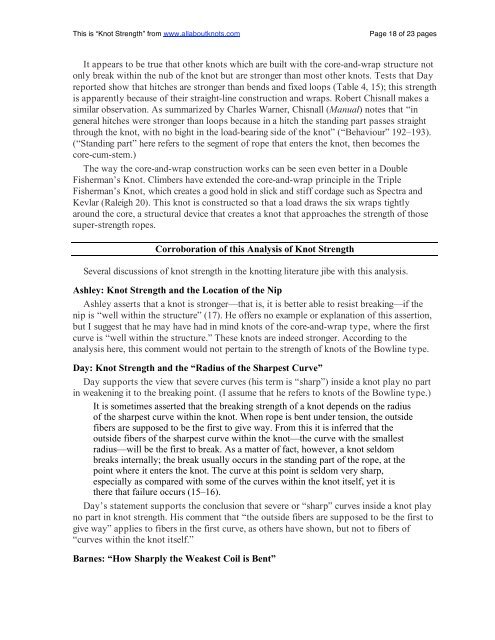You also want an ePaper? Increase the reach of your titles
YUMPU automatically turns print PDFs into web optimized ePapers that Google loves.
This is “<strong>Knot</strong> <strong>Strength</strong>” from www.allaboutknots.com<br />
<strong>Page</strong> 18 of 23 pages<br />
It appears to be true that other knots which are built with the core-<strong>and</strong>-wrap structure not<br />
only break within the nub of the knot but are stronger than most other knots. Tests that Day<br />
reported show that hitches are stronger than bends <strong>and</strong> fixed loops (Table 4, 15); this strength<br />
is apparently because of their straight-line construction <strong>and</strong> wraps. Robert Chisnall makes a<br />
similar observation. As summarized by Charles Warner, Chisnall (Manual) notes that “in<br />
general hitches were stronger than loops because in a hitch the st<strong>and</strong>ing part passes straight<br />
through the knot, with no bight in the load-bearing side of the knot” (“Behaviour” 192–193).<br />
(“St<strong>and</strong>ing part” here refers to the segment of rope that enters the knot, then becomes the<br />
core-cum-stem.)<br />
The way the core-<strong>and</strong>-wrap construction works can be seen even better in a Double<br />
Fisherman’s <strong>Knot</strong>. Climbers have extended the core-<strong>and</strong>-wrap principle in the Triple<br />
Fisherman’s <strong>Knot</strong>, which creates a good hold in slick <strong>and</strong> stiff cordage such as Spectra <strong>and</strong><br />
Kevlar (Raleigh 20). This knot is constructed so that a load draws the six wraps tightly<br />
around the core, a structural device that creates a knot that approaches the strength of those<br />
super-strength ropes.<br />
Corroboration of this Analysis of <strong>Knot</strong> <strong>Strength</strong><br />
Several discussions of knot strength in the knotting literature jibe with this analysis.<br />
Ashley: <strong>Knot</strong> <strong>Strength</strong> <strong>and</strong> the Location of the Nip<br />
Ashley asserts that a knot is stronger—that is, it is better able to resist breaking—if the<br />
nip is “well within the structure” (17). He offers no example or explanation of this assertion,<br />
but I suggest that he may have had in mind knots of the core-<strong>and</strong>-wrap type, where the first<br />
curve is “well within the structure.” These knots are indeed stronger. According to the<br />
analysis here, this comment would not pertain to the strength of knots of the Bowline type.<br />
Day: <strong>Knot</strong> <strong>Strength</strong> <strong>and</strong> the “Radius of the Sharpest Curve”<br />
Day supports the view that severe curves (his term is “sharp”) inside a knot play no part<br />
in weakening it to the breaking point. (I assume that he refers to knots of the Bowline type.)<br />
It is sometimes asserted that the breaking strength of a knot depends on the radius<br />
of the sharpest curve within the knot. When rope is bent under tension, the outside<br />
fibers are supposed to be the first to give way. From this it is inferred that the<br />
outside fibers of the sharpest curve within the knot—the curve with the smallest<br />
radius—will be the first to break. As a matter of fact, however, a knot seldom<br />
breaks internally; the break usually occurs in the st<strong>and</strong>ing part of the rope, at the<br />
point where it enters the knot. The curve at this point is seldom very sharp,<br />
especially as compared with some of the curves within the knot itself, yet it is<br />
there that failure occurs (15–16).<br />
Day’s statement supports the conclusion that severe or “sharp” curves inside a knot play<br />
no part in knot strength. His comment that “the outside fibers are supposed to be the first to<br />
give way” applies to fibers in the first curve, as others have shown, but not to fibers of<br />
“curves within the knot itself.”<br />
Barnes: “How Sharply the Weakest Coil is Bent”

















